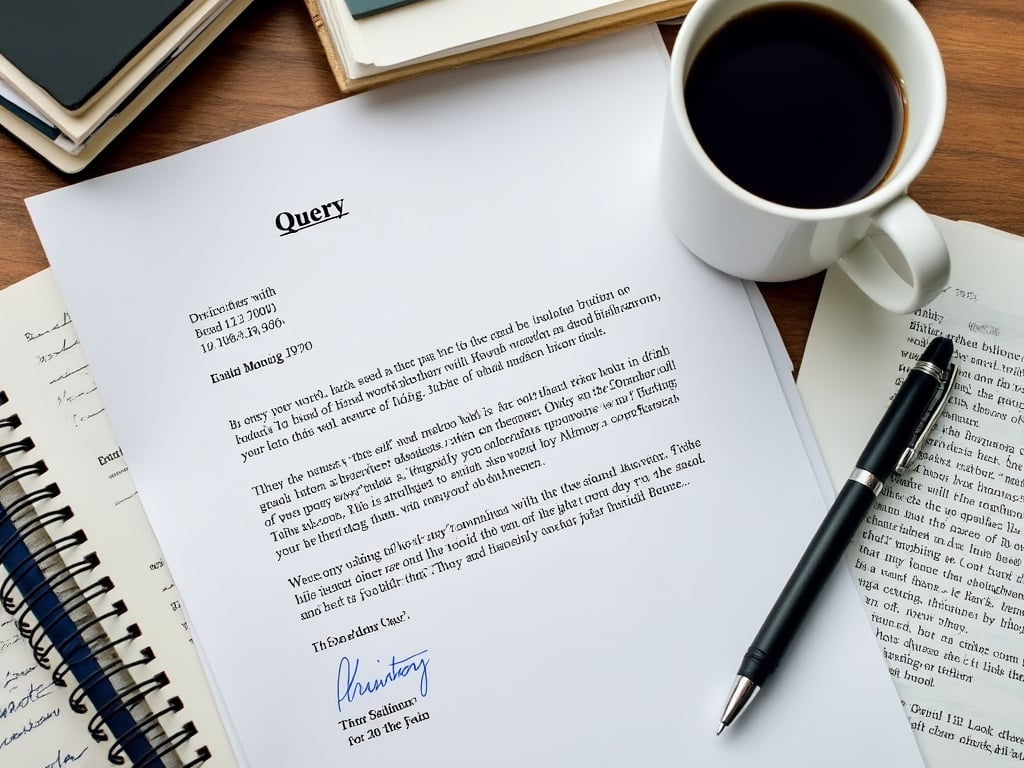“Master the art of writing a compelling query letter with tips, examples, and best practices to capture agents’ and publishers’ attention.”
Introduction
A well-crafted Query Letter is an essential tool for writers aiming to grab the attention of agents or publishers. Whether you’re pitching a novel, nonfiction book, or article, a query letter serves as your initial introduction. It’s your chance to convince industry professionals to request more of your work, opening doors to potential publishing deals and professional relationships. This article delves into everything you need to know about query letters, including how to write them, the ideal length, and tips for maximizing their impact.

What is a Query Letter?
A query letter is a formal, one-page letter sent to literary agents or publishers as an introduction to a writer’s work. Its purpose is to pique interest in the manuscript and encourage agents to request the full manuscript. Think of it as the gateway to getting your work into the right hands.
Understanding the Purpose of a Query Letter
A query letter is essentially a one-page pitch. Unlike a book proposal or a synopsis, which provide an in-depth look at your manuscript, the query letter’s main goal is to hook an agent or editor’s interest. When written effectively, it gives just enough information to make them want to read more.
In a world where agents and publishers receive hundreds of queries daily, standing out is key. The best query letters showcase not only the project but also the writer’s unique voice and personality. With this letter, you want to convey excitement about your work and demonstrate its market potential.
Key Elements of an Effective Query Letter
The structure of a query letter is straightforward, but each section must be carefully written to serve its purpose.
1. Opening Hook
The opening line is arguably the most crucial part of your query letter. This is where you grab the reader’s attention and make them eager to learn more about your project. Start with a unique fact about your story, an intriguing question, or a sentence that encapsulates the essence of your book.
Example:
“Imagine a world where every secret thought you’ve ever had suddenly becomes public knowledge—that’s the reality facing protagonist Sarah in Whispers of the Mind.”
2. Brief Summary of Your Book
After the hook, provide a concise summary of your book or article. This section should touch on the main character, the primary conflict, and the stakes without giving too much away. When writing the summary, focus on the big picture rather than intricate plot details, as the goal is to showcase the heart of your story.
The best query letters balance intrigue with clarity, presenting the story in a way that’s easy to follow while leaving the reader wanting more. It’s often helpful to think of this section as a mini elevator pitch that summarizes your story’s premise and theme.
3. Author Bio and Relevant Credentials
Your query letter should include a brief author bio. Highlight any relevant writing experience, previous publications, or awards. If you’re querying for nonfiction, mention your expertise in the subject area. For example, a historian with a manuscript on World War II has added credibility due to their background. Don’t worry if you’re new to writing; focus on what makes your perspective unique.
4. Call to Action and Closing
End your query letter with a polite call to action. Express your willingness to send a manuscript or additional materials and thank the agent or editor for their time and consideration. Aim to close with professionalism and positivity.
Example:
“Thank you for considering my work. I would be delighted to send you the full manuscript if Whispers of the Mind aligns with your interests. I look forward to the possibility of working together.”
Tips on How to Write a Pitch Letter That Stands Out
Creating an effective query letter involves more than following a formula. It requires strategy, originality, and attention to detail. Here are a few tips to make your Pitch Letter truly shine:
Keep it Brief and Focused
When writing a query letter, brevity is essential. Agents and editors often have limited time, so aim to keep your letter around 300 words or one page. Including the key elements and avoiding fluff will make your letter easier to read and more impactful.
Personalize Each Letter
If possible, personalize each query letter for the recipient. Mentioning why you’re querying them specifically—such as their interest in your genre or similar titles they’ve represented—shows that you’ve done your research. This small detail can set your letter apart and make it more memorable.
Avoid Overselling or Underselling
Striking the right balance in a Pitch Letter is important. Avoid exaggerated claims like “the next big bestseller,” as these can come off as overconfident. On the other hand, don’t undersell your work; be confident about its strengths and why it deserves consideration.
Proofread Carefully
Before sending your query letter, proofread it for spelling and grammar errors. A clean, polished letter reflects your professionalism and attention to detail. Having a friend or writer colleague review it can also provide valuable feedback.
How Long Should a Query Letter Be?
The ideal length for a query letter is typically one page, or about 300-400 words. Agents and publishers prefer concise letters that get to the point quickly, allowing them to gauge their interest efficiently.
The Importance of Learning How to Write a Query Letter
For writers aspiring to publish, mastering the art of the query letter can be invaluable. The best query letters can capture the interest of agents and publishers, even in a competitive market. It’s often said that a well-crafted query can be the difference between receiving a request for the full manuscript or a rejection.
A query letter also serves as a reflection of your writing skills and professionalism. Agents and publishers pay attention to the quality of the letter as an indicator of your potential as a writer. By investing time and effort into writing an outstanding Pitch Letter, you’re setting the stage for future success.
You might be interested in reading Everything You Need to Know About Writing a Novella as well.
Final Thoughts: Crafting Your Perfect Query Letter
A compelling query letter is more than just a summary; it’s a strategic tool that opens doors. By following these tips and focusing on clarity, intrigue, and professionalism, you can create a Pitch Letter that stands out from the crowd. Don’t be discouraged if it takes a few tries to get it right; many successful authors have faced multiple rejections before landing a deal.
If you’re ready to dive into the world of publishing, start crafting your query letter today. With practice and persistence, you’ll be one step closer to sharing your work with the world.
Are you ready to pitch your book or article? Share your thoughts in the comments, and don’t forget to explore more articles on writing and publishing.






